Solutions for Creating Nanoemulsions
Nanoemulsions are an increasingly popular way to incorporate active ingredients into different formulations across a wide range of industries. Microfluidizer® Processors provide a scalable solution for nanoemulsion formulations and are trusted for research, development and production in many different applications.
What is Microfluidizer® Technology?
Microfluidization is a unique method for creating nanoemulsions that utilises controlled shear force to homogenise the sample. The technology is based on a high-pressure system that generates high shear rates, resulting in uniform droplet sizes and stable emulsions. This method is ideal for creating nanoemulsions in a variety of industries including creating next- generation pharmaceuticals as well as cannabis products.
Browse solutions for creating nanoemulsions below; call us on +44(0)1954 232 776 or email info@analytik.co.uk to discuss your requirements with a specialist.
The Benefits of Microfluidizer® Processing Technology for Creating Nanoemulsions
| Microfluidizer® technology | Details | |
|---|---|---|
| Performance – Narrow droplet size distribution | Yes | Less than 200nm |
| Scalable – guaranteed scalability (linearly). | Yes | 2ml – 1,000L + |
| Optimal Temperature Control – Effective and efficient cooling system integration. | Yes | Temperature sensitive samples, temperature range approximately 4 – 60° |
| Contamination Free | Yes | Clean-in-place without disassembly |
| Constant Shear Rate – constant, high-pressure system. | Yes | Consistent results – narrow size distribution |
| Maintenance – robust system with regular preventative maintenance. | Yes | Low cost of ownership – easy user maintenance |
View the Nanoemulsion Microfluidizer® Range
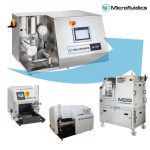
The LM20 is an ideal Microfluidizer® for formulating nanoemulsions. Digital control allows allows repeatable results processing, 30,000 psi capability is enough shear rate to reach low nanometre – range droplets in few passes.
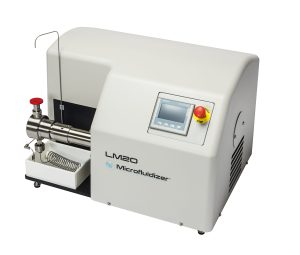
Hover on the image to zoom
The M110P model is the top of the line benchtop Microfluidizer, it has a wide variety of options to suit all applications and offers increased durability for larger batch volumes.
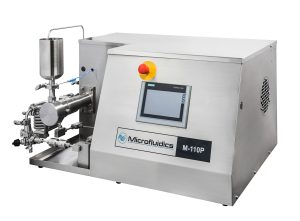
Hover on the image to zoom
The M110EH is a small pilot-scale Microfluidizer; widely configurable and small enough for R&D but equipped to serve as a small-scale pilot or production machine.
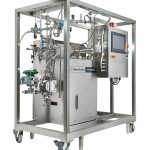
Hover on the image to zoom
The above Microfluidizer® models are the most popular for creating nanoemulsions amongst our customers’ applications, however other Microfluidizers are available.
Proven Processing Solutions
Microfluidizer® technology plays a crucial role in the precise control of particle size in various nanoemulsion applications. These applications are widespread across different industry sectors such as pharmaceuticals, vaccines, cosmetics, personal care, food, and nutraceutical, as well as chemical and industrial sectors. Microfluidizer® technology has proven to be highly effective in creating stable nanoemulsions that can be efficiently sterile filtered.
- Sterile Filtration: Small and narrow droplet size distribution. Specifically in the pharmaceutical industries, recovering high amount of API (active pharmaceutical ingredients), in processes where sterile filtration is required.
- Parental: Microfluidics is widely used for FDA approved parental formulating.
- Aseptic: Microfluidizers from lab to pilot and production are available in GMP and Aseptic specification.
Watch the recording of a webinar hosted by our customer PALL Life Sciences on sterile filtration on complex liquids: challenges and optimisation using a liposomal model fluid.
Find out more about our solutions for pharmaceutical nanoemulsion formulations >
Professor Steve Armes FRS of the University Sheffield and his colleagues examines how subtle differences in nanoparticle emulsifiers affect the long-term stability of Pickering nanoemulsions towards Ostwald ripening using the Microfluidizer® Processor. It is well-known that micron-sized oil droplets can be stabilised using polymer latex particles of 100 – 1000 nm diameter. In this particular study, an LV1 Microfluidizer was used to prepare Pickering nanoemulsions using sterically stabilised deblock copolymer nanoparticles of less than 30 nm diameter. Find out more >
One of the significant advantages of using Microfluidizer® technology is that it allows the processing of small samples as little as 2 mL with an assurance that it can be scaled up to hundreds of litres per hour using production scale machines with identical outcomes. This is made possible by the fixed geometry Interaction Chambers™ present in each model.
“We are indebted to the excellent technical support provided by Analytik, which has enabled us to fully exploit the high-pressure LV-1 Microfluidizer® for the production of well-defined nanoemulsions. We will be seeking their support and advice in the future as we seek to extend our studies to include water-in-oil nanoemulsions.”
Professor Steve Armes, Department of Chemistry, University of Sheffield
Creating Translucent Stable Emulsions with Microfluidizer® Processors
Producing nanoemulsions with small particle sizes and narrow size distributions provides numerous benefits. Emulsion and suspension instability and phase separation are common challenges that can hinder the production and research process.
Creating stable nanoemulsions is a daunting task for research and production teams, as most available technologies cannot produce the required particle size distribution to achieve their product goals.
Fortunately, Microfluidizer® Processors overcome these challenges with a unique fixed-geometry Interaction Chamber™ that uniformly reduces particle sizes to a level unmatched by other methods. This not only optimises formulations and improves stability, but also offers cost efficiencies by extending the shelf life of products.
The stable emulsions achieved through Microfluidics equipment enable the creation of a translucent appearance for various products, including cosmetics and food. This unique and innovative approach sets Microfluidizer® Processors apart and enables customers to achieve their production and research goals with ease.


Microfluidizer® technology creates nanoemulsions with:
- Extremely slow droplet size
- Narrow particle size distribution
- Increased stability
- Filter sterilizable to avoid costly aseptic processing
Microfluidizer® processors are:
- Easy to operate
- Reliable with low maintenance cost
- Linearly scalable from 2ml to Liters per hour
- Comply with cGMP regulations
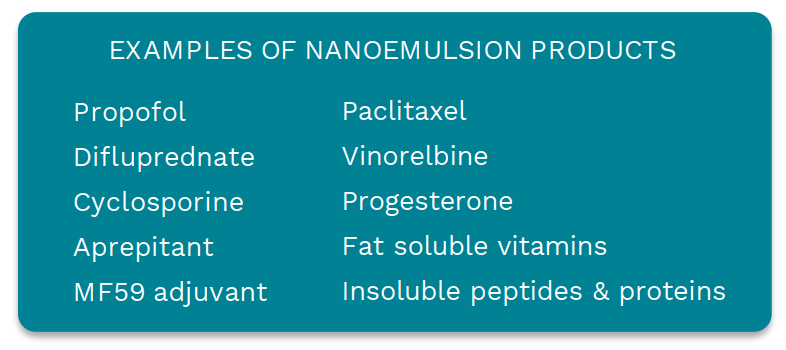
How does Microfluidizer® Processing Compare with Other Technologies?
Ultrasonication is widely used method for creating nanoemulsions, but it has some limitations in formulation and scalability. It can be difficult to achieve a narrow droplet size distribution, and the process can be time-consuming and energy intensive. In contrast, Microfluidizer technology offers a controlled shear rate range, which enables researchers to optimise process parameters to achieve desired particle size while minimising excess energy in the system. This leads to a more efficient and consistent process, resulting in high-quality nanoemulsions with narrow droplet size distribution.
While there are many methods available to create nanoemulsions, Microfluidizer technology offers a superior approach due to its controlled shear rate range, resulting in efficient and consistent production of high-quality nanoemulsions with a narrow droplet size distribution.
What are High Pressure Homogenisers and Microfluidizers?
‘High pressure homogeniser’ (HPH) is a general term used to describe a piece of equipment that forces a stream of liquid sample through a system which applies a number of forces to ‘homogenise’ the sample, that is, to reduce the particle size of its components. There are many applications for this process – whenever an emulsion or suspension would benefit from greater efficacy, stability and downstream processing from smaller constituent particles, high pressure homogenisation may be a valuable process solution. Microfluidizers are a further developed form of HPH.
A HPH typically uses a valve assembly to restrict flow, build pressure and subsequently force fluid through the opening valve at high velocity to apply shear forces to the liquid being processed. This relatively simple technology is widely used and highly effective in processing very large-scale batches of product where a high degree of control over the particle size and distribution isn’t required.
Where Microfluidisation differs is that the shear rate applied to the liquid is higher and uniformly applied to the total sample volume. This is achieved by using a fixed geometry microchannels rather than valves and sophisticated hydraulic system to apply constant pressure. This addresses the common problems of valve high pressure homogenisers when users are seeking higher quality formulations of high value/advanced materials where particle size and distribution has a significant impact on the performance characteristics of the product.
This relatively simple but reliable technology is widely used and highly effective in processing very large scale batches of product where a high degree of control over the particle size and distribution isn’t required.
Where Microfluidisation differs is that the shear rate applied to the liquid is higher and constant, this is achieved by using a fixed geometry microchannels rather than valves and a more sophisticated hydraulic system to apply constant pressure. This addresses the common problems of valve high pressure homogenisers and makes Microfluidizers a better choice where the top level of performance is desired, typically in high-value/advanced materials where particle size and distribution has a significant impact on the performance characteristics of the product.
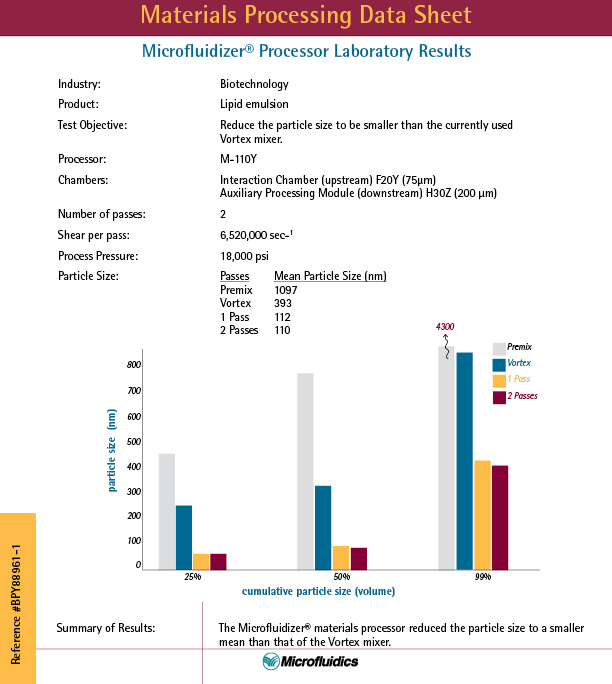
Our customers
CAN’T FIND WHAT YOU’RE LOOKING FOR?
Fill out a Contact Form, call +44(0)1954 232 776 or email info@analytik.co.uk to discuss your requirements with a specialist.










